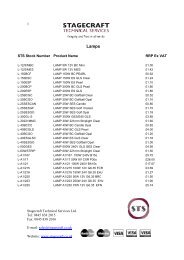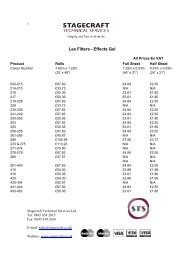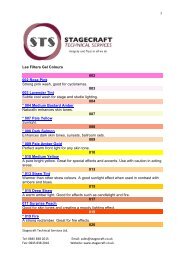You also want an ePaper? Increase the reach of your titles
YUMPU automatically turns print PDFs into web optimized ePapers that Google loves.
DIGITAL MIXINGMixing audio signals in the digital domain provides icon with its powerful processing tools,programmability and sonic clarity well beyond the capability of traditional analog mixing.However, no additional expertise or equipment is required for operation. The audio signalsenter and leave in standard analog format, and the usual familiar controls are presented.The input sources are matched to the operating level of the mixer through high grade preamps,then converted to digital signals using A/D (analog to digital) converters. In the digitaldomain audio signals are represented as binary numbers which are mixed and processed by theDSP (digital signal processor) by applying mathematical operations known as algorithms. Nomatter how complex these algorithms they are always accurate and do not suffer the usualnoise, distortion and crosstalk problems associated with analog mixing. An algorithm is thedigital equivalent of an electronic circuit. The circuits in analog mixers can be complex, takeup considerable space and are not easily modified once built. Digital algorithms are stored asdata in computer memory and can be easily adapted in software. A built in computer reads thechanges you make to the controls and sends instructions to the DSP accordingly. The controlsettings can be stored as digital data in memory for recall later. Once processed the signals areconverted back to analog audio using D/A (digital to analog) converters. The computeroperations are determined by a software program which is loaded in memory. The iconincludes an RS232 serial computer port which allows for future upgrades to this software aswell as the archiving of user data.THE USER INTERFACEThe icon retains an easy-to-use control panel with familiar controls. Multi level menus areavoided. Important performance controls such as channel gain, faders, mute switches,amplifier levels and headphone monitoring are instantly accessible. Access to the auxiliarymixes and signal processing such as EQ, dynamics and effects is by a single key press whichassigns the function of 10 rotary controls and associated LCD display. This is known as the‘soft strip’ as its function is determined by the row of select keys beneath. For example, it canbecome a channel EQ with simultaneous control of all four bands, or it can be used to set upthe foldback mix with all channel sends presented at the same time. A cursor keypad providesmenu control and additional editing functions including copy, paste, undo and reset.The icon soft strip keeps the layout simple and logical with easily accessed controls. The keysare shaped and grouped according to function and together with the LCD display are backlitfor operation in low lighting conditions. The display provides instant visual feedback of thecontrol settings, EQ response curve, setup menus and memory names using large text easilyread from the performance position.The icon can be put into standby mode when leaving the mixer unattended or reconfiguringequipment. Pressing the front panel standby switch disconnects the loudspeakers, mutes alloutputs and disables the controls.MIXING THE AUDIO SIGNALSThe channel signals are mixed and routed to the outputs using the faders and level controls.Signals can be panned between left and right in the main LR mix to create a stereo image.The balance and level of the FB monitor and AUX mixes is independently controlled. Eachinput and output has its own channel strip with 100mm fader, mute switch to turn the signal onor off, PFL switch so that the signal can be independently monitored using headphones, andpeak indicator to warn if the signal level is too high. The fader always takes control of thechannel signal level and is not automated. However, a trim function is provided so that leveldifferences between songs or scenes can be stored in memory if required. With the faders setat normal ‘0’ position, recalling the memories adjusts the levels as programmed. For example,this can be useful when backing tracks have been recorded at different levels and wouldotherwise require manual adjustment during performance.1 - 4 icon SERIES









